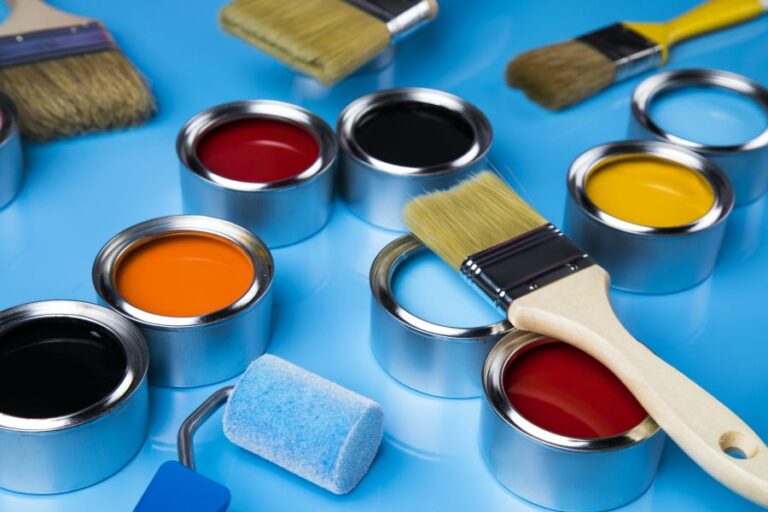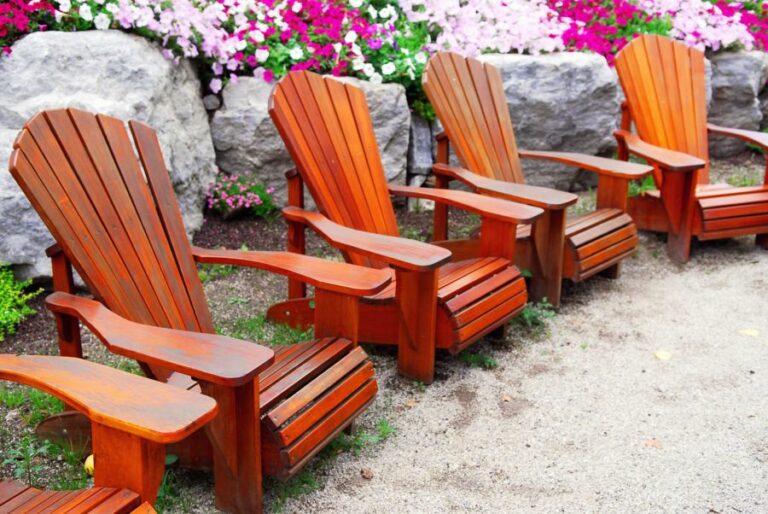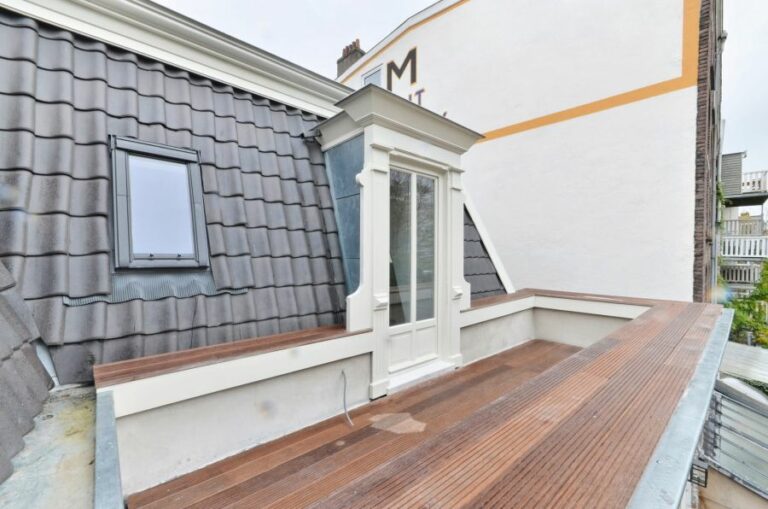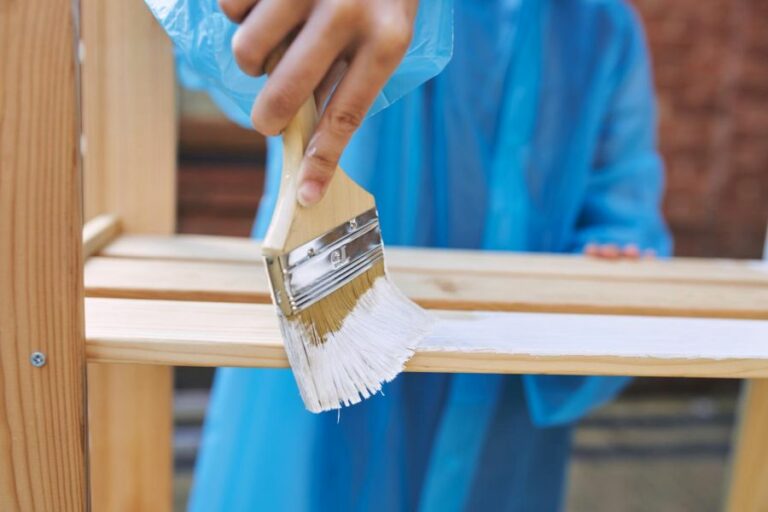Outdoor Wall Paint, 25 Things You Should Know
Your home’s facade reflects your taste and personality, so why not make it as unique as you are? I will push you into a world of vibrant colors and endless possibilities, ensuring that your outdoor walls turn into an eye-catching masterpiece. I’ll cover everything from selecting the perfect hue to the best paint brands and application techniques.
Outdoor wall paint:
The right outdoor wall paint is crucial for durability and aesthetics, considering factors like surface material, climate, and finish. Various weather-resistant paints, such as acrylic latex, oil-based, elastomeric, and mineral-based paints, each with specific benefits and drawbacks. Environmentally friendly low or zero-VOC paints are a popular alternative. Expert recommendations include Sherwin-Williams Duration Exterior, Benjamin Moore Aura Exterior, BEHR Premium Plus Ultra Exterior, Valspar Duramax Exterior, and KEIM Mineral Silicate Paint.

Discover top outdoor wall paint options, durability factors, and application techniques to boost your home’s aesthetics and value. This detailed guide covers essential tips, trending colors, eco-friendly choices, and expert recommendations to achieve magnificent exterior transformations.
Dive in for a visually stunning experience!
Contents
- 1 Exterior Wall Coating and Paint
- 2 Which Type of Paint is Most Suitable for Exterior Walls?
- 3 What is the term for paint used on outdoor walls?
- 4 What is the Most Long-Lasting and Durable Exterior Wall Paint for Home Use?
- 5 What is the most effective method for painting exterior walls of a house?
Exterior Wall Coating and Paint
When it comes to painting exterior walls, choosing the right outdoor wall paint is vital for both durability and aesthetics. With endless color options and paint types available, finding the perfect product for your project can feel overwhelming.
• The Importance of Weather-Resistant Paint
Exterior walls are exposed to various elements, including harsh weather conditions, humidity, sunlight, and pollution. Consequently, it is crucial to use weather-resistant paint specifically designed for outdoor use.
These paints are formulated with unique properties that help resist degradation caused by these factors, ensuring long-lasting protection and curb appeal.
– Types of Weather-Resistant Paint
There are several types of exterior wall paint available, each with its own set of benefits and drawbacks:
- Acrylic latex: Acrylic latex paints are suitable for both exterior and interior applications. They offer excellent adhesion, flexibility, and water resistance, making them an ideal choice for outdoor walls. They also resist mildew and color fading, ensuring long-lasting beauty for your home’s exterior.
- Oil-based paint: Oil-based paints are highly durable and offer excellent resistance to wear and tear. However, they are more challenging to apply and clean up compared to acrylic latex paints. Additionally, they are not as eco-friendly as other alternatives.
- Elastomeric paint: Elastomeric paints are known for their incredible elasticity, which helps prevent cracks and provides a watertight seal. This attribute makes them especially beneficial for stucco and masonry surfaces that contract and expand due to temperature fluctuations. However, elastomeric paints can be pricey and may not provide the desired finish on certain surfaces.
- Mineral-based paint: Mineral-based or silicate paints are highly durable and offer excellent resistance to UV light, moisture, and pollutants. They are ideal for mineral substrates like natural stone, concrete, or brick. However, they may not adhere well to previously painted surfaces.
• Factors to Consider When Choosing Outdoor Wall Paint
– Surface Material
Not all exterior wall paints are suitable for every surface. Choosing a paint that adheres well to the surface material of your exterior walls is essential, whether it be wood, masonry, stucco, or metal.
For instance, elastomeric and mineral-based paints are excellent options for masonry and stucco, while acrylic latex paints are versatile and suitable for various surfaces.
– Climate
Different outdoor wall paints provide varying levels of protection against specific climate conditions. For example, consider a paint with enhanced mildew resistance in humid or wet climates. Opt for a paint formulated to resist sun damage and color fading in arid or high-UV regions.
Your local paint store will likely have recommendations on the best paints for your area’s climate.
– Finish
Exterior wall paints come in various finishes, which can significantly impact the final appearance of your home:
- Matte: Matte finishes offer a non-reflective appearance that can conceal minor imperfections on the surface.
- Satin: Satin finishes provide a slight sheen, offering a balance between matte and glossy finishes. They are easy to clean and can somewhat resist dirt and moisture.
- Semi-gloss/gloss: Glossy finishes are highly reflective and can draw attention to textured surfaces or imperfections, but they are also incredibly durable and easy to clean.
– Eco-Friendly Options
Environmentally friendly paints have gained popularity in recent years as a sustainable alternative to traditional outdoor wall paint. These paints are typically low or zero VOC (volatile organic compounds), which means they emit fewer harmful chemicals during the drying process.
Opting for a more eco-conscious paint can help reduce your carbon footprint and create a healthier living environment.
• Expert Recommendations for Outdoor Wall Paint
Based on my experience, I recommend the following outdoor wall paint products:
- Sherwin-Williams Duration Exterior: This acrylic latex paint is known for its durability, excellent adhesion, and resistance to mildew and color fading. It is an excellent all-around choice for exterior walls.
- Benjamin Moore Aura Exterior: This premium acrylic latex paint offers exceptional durability, quick drying, and superior color retention. It also contains a built-in primer, saving time and labor during the painting process.
- BEHR Premium Plus Ultra Exterior: As a paint and primer in one, this acrylic latex product is renowned for its excellent coverage, durability, and mildew resistance.
- Valspar Duramax Exterior: This high-quality acrylic latex paint is designed for excellent adhesion and resistance to chipping, cracking, and fading.
- KEIM Mineral Silicate Paint: This high-performance mineral-based paint is perfect for mineral substrates, offering superb durability and weather resistance.
• Conclusion
Selecting the right outdoor wall paint is an investment in the long-term appearance and protection of your home’s exterior.
By considering factors like surface material, climate, and personal preferences, you can find the perfect paint for your unique needs. And by opting for a high-quality product, you can ensure a beautiful and long-lasting finish that will enhance your home’s curb appeal for years to come.
Which Type of Paint is Most Suitable for Exterior Walls?
The importance of picking the right paint for your outside walls cannot be overstated. A well-chosen paint can enhance the appearance of your property, protect it from the elements, and reduce the need for frequent repainting.
With so many options on the market, selecting a suitable paint for your needs can be challenging.
• Acrylic vs. Oil-Based Paint: Which is Better?
Two main types of paints are commonly used for exterior walls: acrylic and oil-based. To make an informed decision, it’s crucial to understand the primary differences between the two.
– Acrylic Paint
Pros:
- Water-based, making it easier to clean up and better for the environment.
- Greater resistance to UV rays, which prevents fading over time.
- Quick-drying, allowing for faster touch-ups and second coats.
- Less susceptible to cracking and chalking.
Cons:
- May not adhere as well to certain surfaces, requiring more preparation.
– Oil-Based Paint
Pros:
- Excellent adhesion to various surfaces, including wood, metal, and masonry.
- High durability, ensuring long-lasting protection.
- Glossier finish, providing a polished appearance.
Cons:
- Longer drying time, delaying touch-ups and second coats.
- Harsher fumes, posing potential health risks.
- Harmful chemicals, contributing to environmental concerns.
- Prone to yellowing over time
Based on these considerations, using acrylic paint for exterior walls is generally recommended. Not only does it offer superior resistance to the elements, but it’s also more environmentally friendly and easier to work with.
• Factors to Consider While Selecting Exterior Wall Paint
– Surface Material
The type of surface you’re painting will play a significant role in selecting the appropriate paint. For instance, acrylic paint may struggle to adhere to chalky or porous materials like concrete or brick. An acrylic masonry primer can be used to increase adhesion and ensure a long-lasting finish.
Select a paint formula specifically designed for wood surfaces, as it will provide better protection against moisture and rot.
– Climate Conditions
The local climate should be taken into account when choosing exterior paint. Ensure the paint you select is suitable for the area’s temperature range and humidity levels.
Some paints are formulated with additives to help resist mildew, mold, and fading, making them an excellent choice for regions with high humidity or intense sunlight.
– Paint Finish
Consider the finish you prefer on your exterior walls. While glossy finishes may provide an attractive appearance, they can also highlight imperfections on the wall. Satin and matte finishes can work to conceal minor imperfections and provide a more uniform look across the surface.
– Color Selection
Choosing the right color can enhance the curb appeal of your property. Darker colors tend to absorb more heat, making them less energy-efficient in hotter climates.
On the other hand, lighter colors can help reflect sunlight and keep your home cooler. Moreover, if your home is part of a homeowners’ association, adhere to any exterior paint color guidelines.
• Top-Rated Exterior Paint Brands
While numerous paint brands are available, some stand out in terms of quality, coverage, and durability. The following brands are known for their premium exterior paint offerings:
- Sherwin-Williams Duration: A high-end exterior paint with excellent coverage and durability. It’s self-priming and offers resistance to mildew, making it an excellent choice for areas with high humidity.
- Benjamin Moore Regal Select: This acrylic paint offers outstanding adhesion and coverage. It’s also resistant to UV rays, making it suitable for sunny climates.
- Valspar Duramax: A versatile option that provides exceptional coverage and protection. It’s an all-weather paint designed to withstand various climate conditions, making it a reliable choice for any region.
- Behr Premium Plus: A budget-friendly option with excellent adhesion, coverage, and durability. It’s formulated to resist peeling, cracking, and fading, protecting your exterior walls from the elements.
In conclusion, selecting the best paint for your outside walls requires considering various factors, such as surface material, climate, and desired finish. Generally, acrylic paint is recommended for most exterior walls due to its environmental benefits and resistance to UV rays.
Keep in mind the local climate conditions, and select a paint formula specifically designed for the surface you’re painting. By taking these factors into account, you can ensure a durable and long-lasting finish that enhances the appearance and value of your property.
Paint Type | Pros | Cons |
|---|---|---|
Acrylic Latex | Water-based, easy to clean, dries quickly, flexible and resistant to cracking, good color retention | Not as durable as some oil-based paints |
Oil-Based | Durable, long-lasting, excellent adhesion to various surfaces, tends to resist dirt better than latex | Longer drying time, harder to clean, contains higher VOCs (volatile organic compounds) |
Textured | Can cover surface imperfections, provides a unique appearance, adds a protective layer | Can be difficult to apply, may require professional help |
Mineral-Based (Silicate) | Vapor-permeable, resistant to fading, non-flammable, can last for decades, environmentally friendly | Expensive, requires experienced applicators, limited color selection |
Elastomeric | Flexible, waterproof, can cover hairline cracks, provides excellent weather resistance | Expensive, can be difficult to apply, may require professional help |
What is the term for paint used on outdoor walls?
When it comes to selecting the best outdoor wall paint for your home, it can be a daunting experience with the numerous options available in the market.
Worry not. I will take you through the various types of outdoor wall paints and provide you with expert advice to help you make the right choice for your home.
• Understanding Outdoor Wall Paint
Outdoor wall paint, commonly known as exterior paint, is a specially formulated paint designed to withstand the various elements that outdoor surfaces are exposed to.
These paints are made to be highly durable, weather-resistant, and UV-resistant, ensuring they protect and maintain the aesthetic appeal of your home’s exterior walls for a long time.
– Key Features of Outdoor Wall Paint
- Weather Resistance: One of the most critical aspects of outdoor wall paint is its ability to withstand harsh weather conditions such as direct sunlight, heavy rain, humidity, and temperature fluctuations.
- Durability: Outdoor wall paint is formulated to be highly adhesive and long-lasting, ensuring it doesn’t chip or fade easily.
- UV Resistance: High-quality outdoor paints contain UV-resistant additives that protect your walls from fading and discoloration caused by the sun’s harmful rays.
- Moisture Resistance: Exterior paints are designed to repel water and resist moisture absorption, preventing damage like mold, rot, and peeling.
- Breathability: Outdoor wall paint allows moisture and vapors to escape, ensuring that the walls can adequately breathe and avoid moisture buildup.
• Types of Outdoor Wall Paint
– Acrylic Paint
Acrylic exterior paint, also known as water-based paint, is the most common outdoor wall paint. It’s famed for its durability, ease of application, and fast drying time. Acrylic paint is also weather-resistant and can withstand varying temperature changes.
Pros of Acrylic Paint
- Fast-drying
- Water-based and easy cleanup
- Resistant to mildew and mold
- Excellent color retention
Cons of Acrylic Paint
- May emit some unpleasant odors during application
- Not suited for surfaces with chalky, powdery residues
– Oil-Based Paint
Oil-based outdoor paints provide a smooth and durable finish for your exterior walls. These paints are well-known for their ability to create a strong, water-resistant bond with surfaces, making them ideal for areas with high humidity or moisture levels.
However, they have longer drying times compared to water-based paints, and their cleanup often requires a solvent or mineral spirits.
Pros of Oil-Based Paint
- Durable and long-lasting finish
- Suitable for high-humidity environments
- Resistant to cracking and chipping
Cons of Oil-Based Paint
- Longer drying times
- Solvent-based and difficult cleanup
- Higher levels of volatile organic compounds (VOCs)
– Elastomeric Paint
Elastomeric paint is a unique type of outdoor wall paint that is extremely thick and elastic. It’s an excellent choice for homes with stucco or masonry surfaces, as it can fill and cover cracks and gaps while providing a robust waterproof barrier.
This paint also ensures superior protection against various weather conditions, making it ideal for households in extreme climates.
Pros of Elastomeric Paint
- Exceptional waterproofing capabilities
- Flexible and can cover cracks and gaps
- Ideal for stucco and masonry surfaces
Cons of Elastomeric Paint
- Can be challenging to apply due to its thickness
- More expensive than other outdoor paint options
• Expert Tips to Consider
- Surface Preparation: Properly preparing the surface of your walls is essential for ensuring a long-lasting and neat finish. This includes cleaning, repairing damages, and applying an appropriate primer.
- Weather Forecast: Always check the weather forecast before embarking on your outdoor painting project. Avoid painting when it’s very hot, cold, or rainy and humid conditions.
- Paint Quality: Investing in high-quality paint ensures a better appearance and long-lasting protection for your home’s exterior surfaces. It’s worth spending a little more for reliable and well-performing paint.
- Painting Tools: Invest in high-quality painting tools like brushes, rollers, and extension poles to ensure an easy and efficient painting process.
- Safety Measures: When working on an outdoor painting project, ensure you take adequate safety precautions, such as wearing protective gear, using a stable ladder, and working during non-peak sunlight hours.
• In Conclusion
Selecting the right outdoor wall paint for your home is vital in ensuring a durable, weather-resistant, and visually appealing finish. Familiarize yourself with the types of paint available, consider your home’s unique needs, and follow expert recommendations for a successful painting project.
What is the Most Long-Lasting and Durable Exterior Wall Paint for Home Use?
As a professional painter with years of experience, I can attest to the importance of selecting the right paint for your exterior walls. This is especially true when you’re looking for a product that can withstand the elements and maintain its appearance for years to come.
• Understanding Paint Durability
The durability of a paint is determined by its ability to resist wear and tear over time. This is particularly important for exterior walls, as they are constantly exposed to harsh weather conditions, air pollutants, and direct sunlight.
In general, the most durable wall paints are those with excellent adhesion, resistance to fading and chalking, and resistance to mold and mildew growth.
• Characteristics of the Most Durable Exterior Wall Paint
To get a better idea of what makes exterior wall paint durable, let’s take a look at some of its key characteristics:
– Quality Ingredients
The most durable exterior wall paints are made with high-quality ingredients. These include high-quality pigments that provide vivid and long-lasting color and binders and resins that ensure excellent adhesion and resistance to the elements.
– High Percentage of Solids
A paint’s solids content refers to the non-volatile components of the paint, which include pigments, binders, and other additives. The higher the percentage of solids, the more durable the paint will be. Look for a paint with a solids content of 40% or higher for maximum durability.
– 100% Acrylic Formula
A 100% acrylic formula is a key indicator of durable exterior wall paint. Acrylics provide excellent adhesion, flexibility, and resistance to the elements. In addition, acrylics are resistant to fading and chalking, ensuring that your walls maintain their appearance for an extended period of time.
– UV Resistance
Exterior walls are constantly exposed to harmful sun ultraviolet (UV) rays. UV-resistant paints contain special additives that protect the paint from fading and discoloring due to UV exposure. Look for paints that specifically claim to offer UV resistance for the best results.
– Mold and Mildew Resistance
Mold and mildew can wreak havoc on your paint job, leading to unsightly stains, discoloration, and even paint failure. Durable exterior wall paint should include mold and mildew-resistant additives to prevent these issues from occurring.
• Top Recommendations for the Most Durable Exterior Wall Paint
Based on the key characteristics discussed earlier, here are my personal recommendations for the most durable exterior wall paints currently available:
1. Sherwin-Williams Duration Exterior Acrylic Latex
Duration Exterior Acrylic Latex by Sherwin-Williams is a high-quality, 100% acrylic paint that features advanced acrylic resin technology. This paint offers excellent durability, adhesion, and resistance to fading, chalking, and mildew growth.
In addition, its high solids content ensures a long-lasting, even finish that is resistant to peeling and cracking.
2. Benjamin Moore Aura Exterior Paint
Another excellent option for durable exterior wall paint is Benjamin Moore’s Aura Exterior Paint. This product features the brand’s proprietary Gennex colorant technology, which ensures superior color and fade resistance.
Its 100% acrylic formula offers superb adhesion, flexibility, and resistance to mold and mildew growth.
3. PPG TIMELESS Exterior Paint
PPG TIMELESS Exterior Paint is a high-quality, 100% acrylic paint that is specifically formulated to provide long-lasting protection and beauty to your exterior walls. This paint features a UV-resistant formula that helps prevent fading and built-in mildew and dirt resistance.
Its high solids content ensures excellent coverage and durability, making it an ideal choice for homeowners seeking a long-lasting paint option.
• Final Thoughts on Choosing the Most Durable Exterior Wall Paint
Selecting the most durable exterior wall paint is crucial for ensuring your property’s long-term protection and appearance.
By considering factors such as quality ingredients, percentage of solids, acrylic formula, UV resistance, and mold and mildew resistance, you can make an informed decision and choose a paint that will best suit your needs.
Remember, the investment you make in high-quality paint will pay off in the long run, as it will likely save you from needing to repaint frequently due to fading, chalking, or other issues associated with lower-quality products.
Don’t skimp on quality. Invest in a durable exterior wall paint, and enjoy a lasting and beautiful home exterior.
What is the most effective method for painting exterior walls of a house?
Painting the exterior walls of your house can be a daunting task, but with the right knowledge, tools, and some patience, you can achieve professional-looking results.
• Choose the Right Time and Conditions
– Weather Conditions for Exterior Painting
You must choose the right weather conditions to get the best results when painting exterior house walls. Ideal temperatures for painting are between 50-85F (10-29C). Avoid painting when the humidity is high (above 85%), as this can cause paint to dry too slowly and attract dust and insects.
Additionally, avoid painting in direct sunlight or when surfaces are hot to the touch, as this can cause the paint to dry too quickly and lead to uneven coverage.
– Seasonal Considerations
The best time to paint the exterior of your house is usually late spring, summer, or early fall, as these seasons offer more predictable and favorable weather conditions.
Painting in colder temperatures can cause the paint to lose its elasticity while painting in extremely hot temperatures can cause blistering or peeling.
• Prepare the Surface
– Cleaning the Surface
Proper surface preparation is crucial for achieving professional-looking results when painting exterior house walls. Begin by washing the surface with a pressure washer or a garden hose with a nozzle attachment, focusing on removing dirt, mildew, and chalking.
A mild detergent and water solution is recommended for stubborn dirt and mildew. Rinse thoroughly and allow the surface to dry completely before moving to the next step.
– Repairing and Sanding the Surface
Inspect the surface of your walls for cracks, holes, or other imperfections. Fill any gaps with a suitable exterior-grade filler, following the manufacturer’s instructions. Once the filler is dry, sand any rough or uneven areas with medium-grit sandpaper.
For large areas, consider using a power sander for quicker results. After sanding, wash the surface with water to remove dust and debris and allow it to dry completely.
– Prime the Surface
Primer is essential for proper paint adhesion to the surface and provides a consistent base for the paint to adhere to. It is particularly important for surfaces that have been patched or repaired.
Choose an exterior-grade primer that is suitable for your surface type (wood, masonry, or metal) and follow the manufacturer’s instructions for application. Allow the primer to dry completely before applying the paint.
• Select the Right Paint and Tools
– Choosing the Right Paint
Select a high-quality exterior-grade paint that is suitable for your surface type (wood, masonry, or metal). When choosing the paint, consider factors such as the paint’s durability, ease of application, and resistance to mold, mildew, and UV damage.
Additionally, choose a paint finish that suits your preference and the architectural style of your home (flat, satin, or semi-gloss).
– Choosing the Right Tools
Invest in high-quality tools for painting exterior house walls, as they will save you time and effort while ensuring professional-looking results. Recommended tools include:
- A sturdy ladder or scaffolding for safe and easy access to higher areas
- A high-quality paintbrush (2.5-3-inch) for cutting in and painting trim
- A durable paint roller with an extension pole and suitable roller cover (choose a cover with an appropriate nap length for your surface texture)
- A paint tray or bucket for holding your paint
• Apply the Paint
– Cutting In
Begin by ‘cutting in’ around the edges of the area to be painted using a high-quality paintbrush. This means carefully painting a narrow strip along the perimeter of surfaces, window and door frames, and any other areas that cannot be easily reached with a roller.
This step creates a clean edge and ensures an even finish when rolling.
– Rolling the Paint
Using a paint roller with an extension pole, apply the paint to the walls in a “W” or “M” pattern, working from top to bottom. Then, use the roller to spread the paint evenly throughout the area, filling in the gaps between the patterns.
Be sure to maintain a wet edge, as this helps to prevent lap marks and ensures an even finish.
– Applying Additional Coats
After the first coat of paint has dried thoroughly (follow the manufacturer’s recommendations for drying times), inspect the surface for any uneven coverage or imperfections. If necessary, apply a second coat of paint or touch up any missed areas.
When applying multiple coats, always allow each coat to dry completely before proceeding.
• Finishing Touches
Once the paint is dry, carefully remove any protective or masking materials, such as drop cloths or painter’s tape, and reattach or install any removed hardware, such as shutters, window screens, or lighting fixtures. Finally, clean and store your painting tools and supplies for future use.
You can achieve professional-looking results when painting exterior house walls with careful planning, preparation, and attention to detail.
By following this comprehensive guide and using high-quality tools and materials, you’ll give your home’s exterior a fresh new look that increases its curb appeal and protects it from the elements for years to come.
Step | Description |
|---|---|
1 | Choose high-quality exterior paint and appropriate painting tools. |
2 | Inspect and repair any damage to the exterior walls, including cracks, holes, and loose or peeling paint. |
3 | Clean the exterior walls, removing dirt, dust, mold, and mildew. Allow the surface to dry completely. |
4 | Mask off windows, doors, and other areas you do not want to be painted using painter’s tape and plastic sheeting. |
5 | Prime the walls, especially any areas with repaired damage or exposed bare surfaces. |
6 | Start painting from the top of the house and work your way down. Apply paint in smooth, even strokes using a brush, roller, or paint sprayer. |
7 | Apply a second coat of paint if necessary, allowing sufficient drying time between coats. |
8 | Remove masking tape and clean up the area, including properly disposing of used paint cans and materials. |







